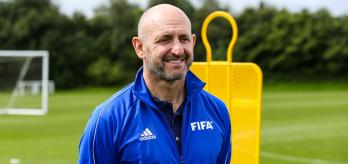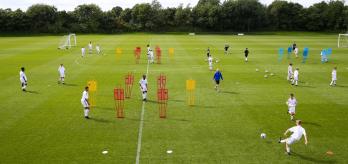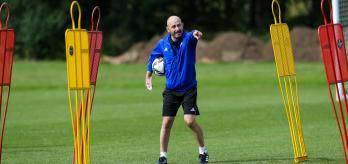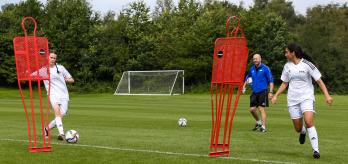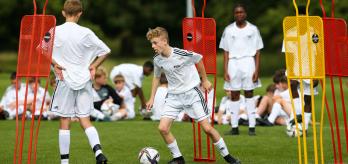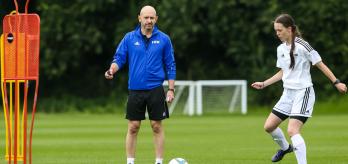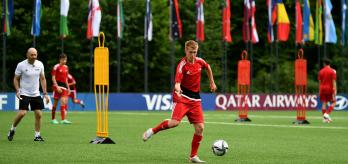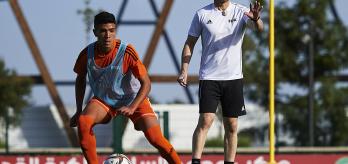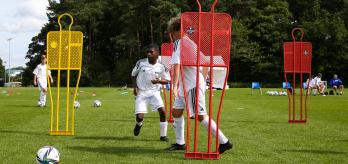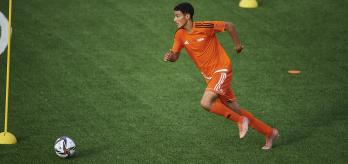The drills seek to improve the level of technical understanding between players and optimise ball contact time. This circuit, as is the case with all of the others in this series, can be set up in different sizes (small, medium and large) so as to allow for various ranges of passing and movement and different combinations. The circuit that features in this article is medium-sized.
Set-up for all drills

Organisation
- Lay out a 20x20m square using flat green cones (a).
- Create two, 2m-wide gates using flat blue cones (b).
- Position red mannequin gates 5m from the flat blue cones (c).
- Place the red mannequins 2m apart from each other (d).
- Position the two red gates 10m apart (e).
- Place two blue mannequins 10m apart (f).
- In the event that no mannequins are available, cones/discs or poles may be used instead.
Drill duration
- 5 players: 2 to 3 minutes.
- 6 to 7 players: 3 to 4 minutes.
Approximate workload intensity
- 5 players (optimum number): medium to higher intensity.
- 6 players: lower to medium intensity.
- 7 players: lower intensity.
Coaching points that apply to all drills
- Allow players 30 seconds to find their tempo and familiarise themselves with the scenario, before gradually raising the intensity demands.
- Devote a period of time (minimum of 1 minute) during each drill to focus on high tempo, correct technique, technical balance and reinforcement of awareness habits.
- Encourage players to move quickly between positions.
Drill 1: Move ball on first touch, play it on second
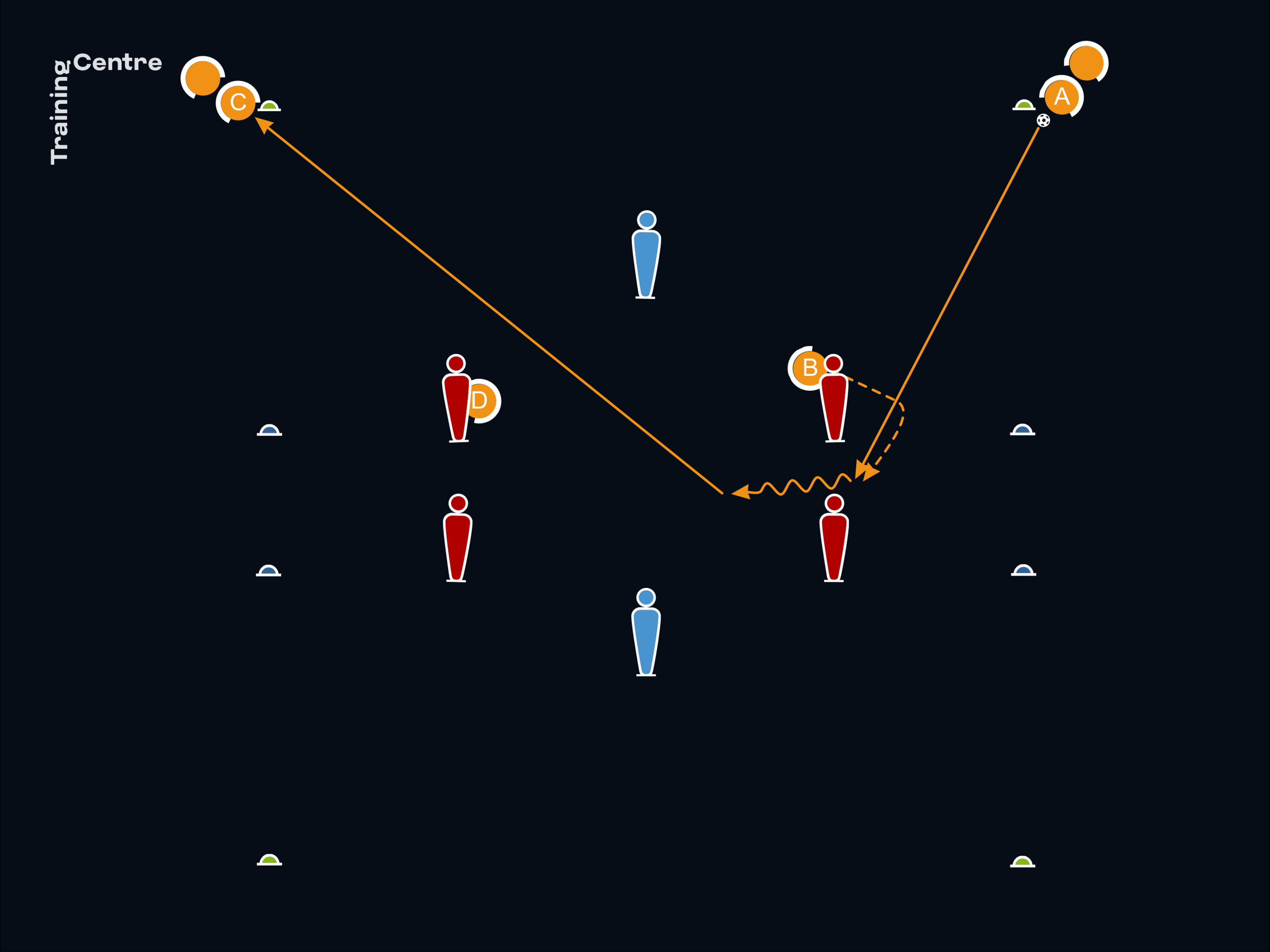
- A plays a pass between the gate to B.
- B quickly appears from behind the gate to occupy the space in front of it and, positioned as if set to peel away on the half-turn, lets the ball run across their body to the farthest foot, before pushing it forward and driving through the gate with their first touch.
- With their second touch, B quickly plays a forward diagonal pass to C.
- C then follows the same sequence with D.
- Every player follows their pass to ensure player rotation.
- A moves to B.
- B moves to C.
- C moves to D.
- Encourage "server" players (A and C) to be switched on and ready to play the pass quickly.
- Players should play with their heads up and scan the area they are receiving the pass from and where they intend to pass to.
- Place the emphasis on playing a quality pass into the path of the next player in the sequence.
- This drill is technically balanced, requiring an equal use of left and right foot.
- Players are to move the ball forward and into space with their first touch whilst on the half-turn, before quickly playing a diagonal pass with their second touch.
- B should shift the ball on to their left foot and play a left-footed pass. D should shift the ball on to their right foot and play a right-footed pass.
Drill 2: First-time pass down the line and coming inside
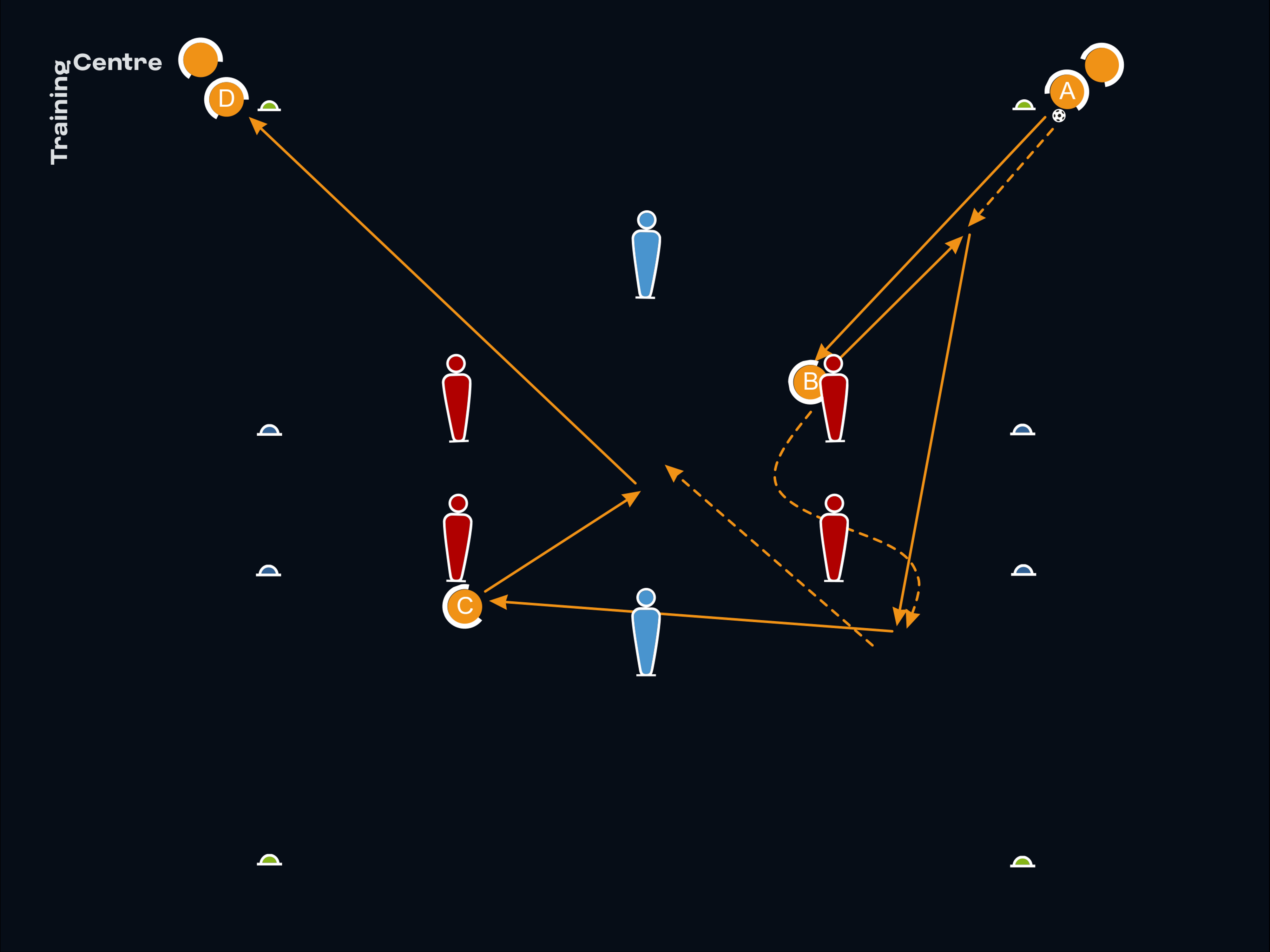
- A plays a pass to B at the outer edge of the gate.
- B appears from behind the gate and takes a position on the outer side of it, before laying the ball back to A.
- B then runs through the gate at pace and peels away on the half-turn.
- B advances past the gate, taking a touch if necessary, before playing a straight pass down the line to C.
- B makes a diagonal run on the inside to receive the lay-off played by C.
- B completes the sequence by playing a first-time pass to D, who is situated at the other end of the grid.
- D then starts the same sequence with C, who becomes the main player.
- A moves to B.
- B follows their pass to D.
- After having laid the ball off, C returns to the starting position and begins a new sequence with D.
- Emphasise and encourage the one-touch and movement aspects of this drill.
- Players should play with their heads up and scan the area they are receiving the pass from and the intended destination of their own pass.
- Place the emphasis on playing a quality pass into the path of the next player in the sequence.
- Where possible, play a first-time pass when changing direction.
- Focus on the quality of the first-time lay-off and pass into the recipient's path.
- This drill is technically balanced, requiring an equal use of left and right foot.
- The initial diagonal pass should be returned to A with a left-footed pass.
- The straight pass to C should be a left-footed pass.
- The diagonal pass to D should be a right-footed pass.
- The opposite feet to those stipulated above are to be used when D restarts the sequence (right foot, right foot, left foot).
Drill 3: Play inside, move diagonally around the outside
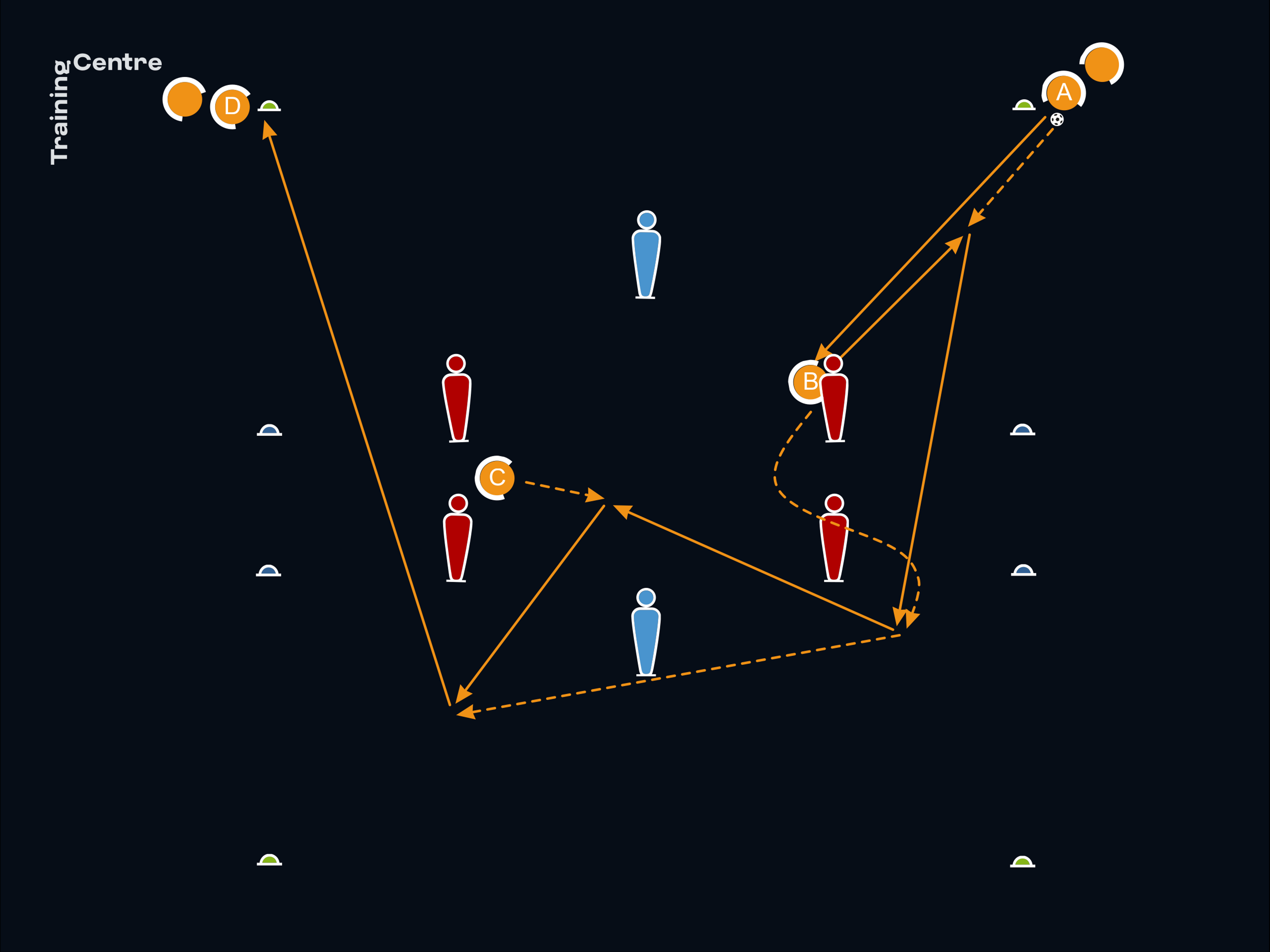
- The sequence begins in the same way as Drill 2. A plays a pass to B, who lays the ball back before running at pace through the gate and peeling away on the half-turn.
- It is at this point that the sequence differs. B should try to let the return pass run past the gate, taking a touch if necessary, before playing a diagonal pass on the inside to C, who moves inside to receive the pass.
- B then makes a driving run on the outside and advances past the wide mannequin to meet the first-time return pass from C.
- If possible, B then plays a first-time diagonal pass to D, who is situated at the other end of the grid.
- If unable to play a first-time pass, B can take a touch by pushing the ball into space, before proceeding to quickly play a diagonal pass to D.
- A moves to B.
- B moves to D.
- C returns to the upper mannequin gate and starts a new sequence with D.
- Emphasise and encourage the one-touch and movement aspects of this drill.
- Players should play with their heads up and scan the area they are receiving the pass from and the intended destination of their own pass.
- Place the emphasis on playing a quality pass into the path of the next player in the sequence.
- This drill is technically balanced, requiring an equal use of left and right foot.
- The first pass played back to A should be a left-footed pass.
- The pass played to C in the centre of the grid should be a left-footed pass.
- The diagonal pass to D should again be a left-footed pass.
- When D starts the next sequence with C, all passes should be right-footed.
Drill 4: Play straight pass, move and play pass to opposite end of grid
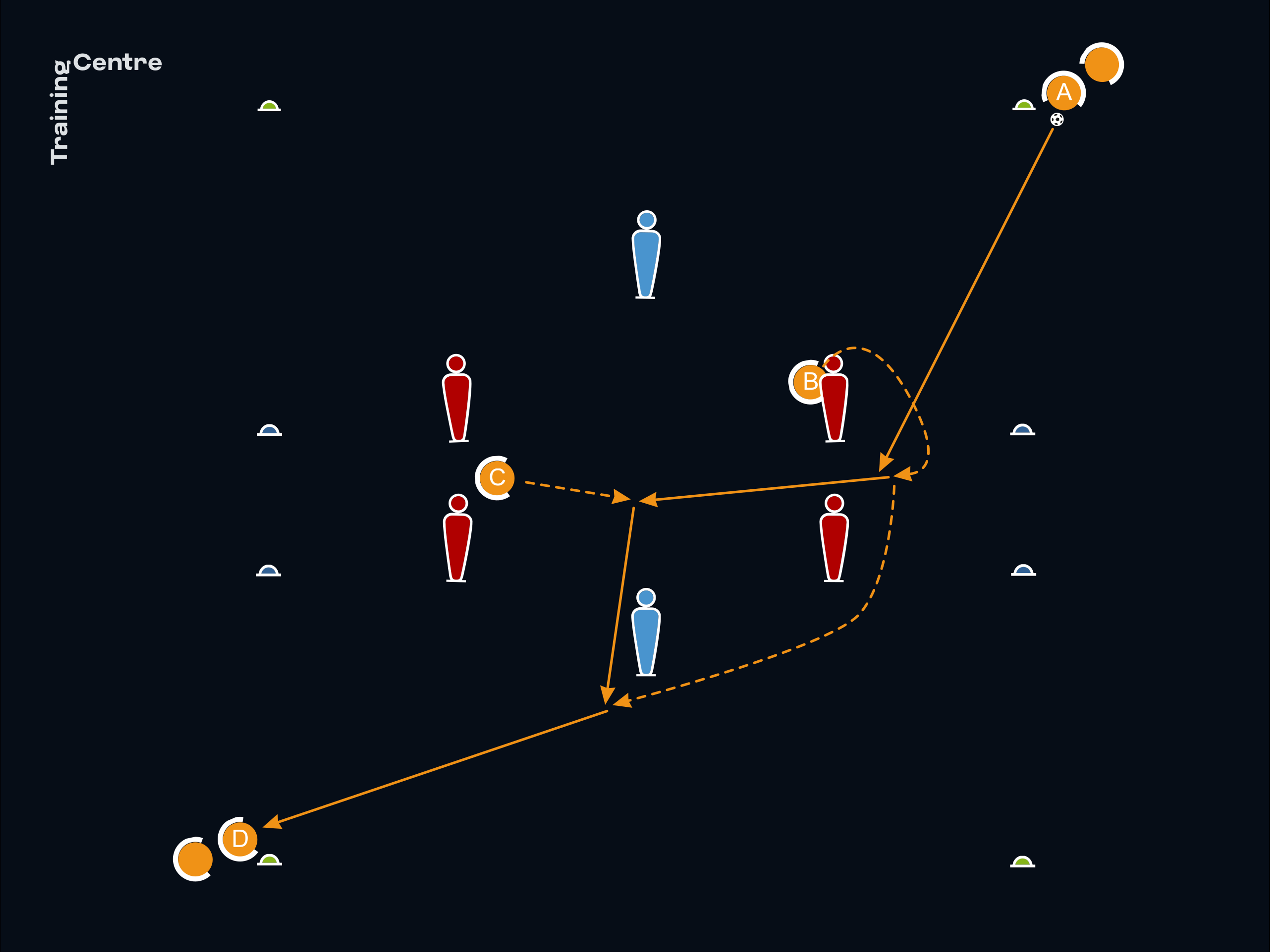
- A plays a pass to B into the space between the gate.
- B appears from behind the gate and shows quick feet to get into a position to play a first-time pass to C, who is situated at the other gate.
- B races around the outer mannequin to receive a first-time pass from C.
- B plays a short, first-time pass to D to complete the sequence.
- D then starts the same sequence with C, who becomes the main player.
- A moves to B.
- B moves to D.
- C returns to the upper mannequin gate to become the main player in the next sequence with D.
- Emphasise and encourage the one-touch and movement aspects of this drill.
- Players should play with their heads up and scan the area they are receiving the pass from and the intended destination of their own pass.
- Place the emphasis on playing a quality pass into the path of the next player in the sequence.
- NB: to promote complete technical balance, the directions and organisation should be inverted so as to encourage efficiency of movement and two-footedness.
- Focus on quick feet.
- When starting the sequence from the top right-hand corner, both of the passes played by B should be left-footed.
- The lay-off played by C should also be left-footed.
- After inverting the set-up, B and C should play right-footed passes to promote technical balance.
Drill 5: Quick feet to let ball run and first-time diagonal pass
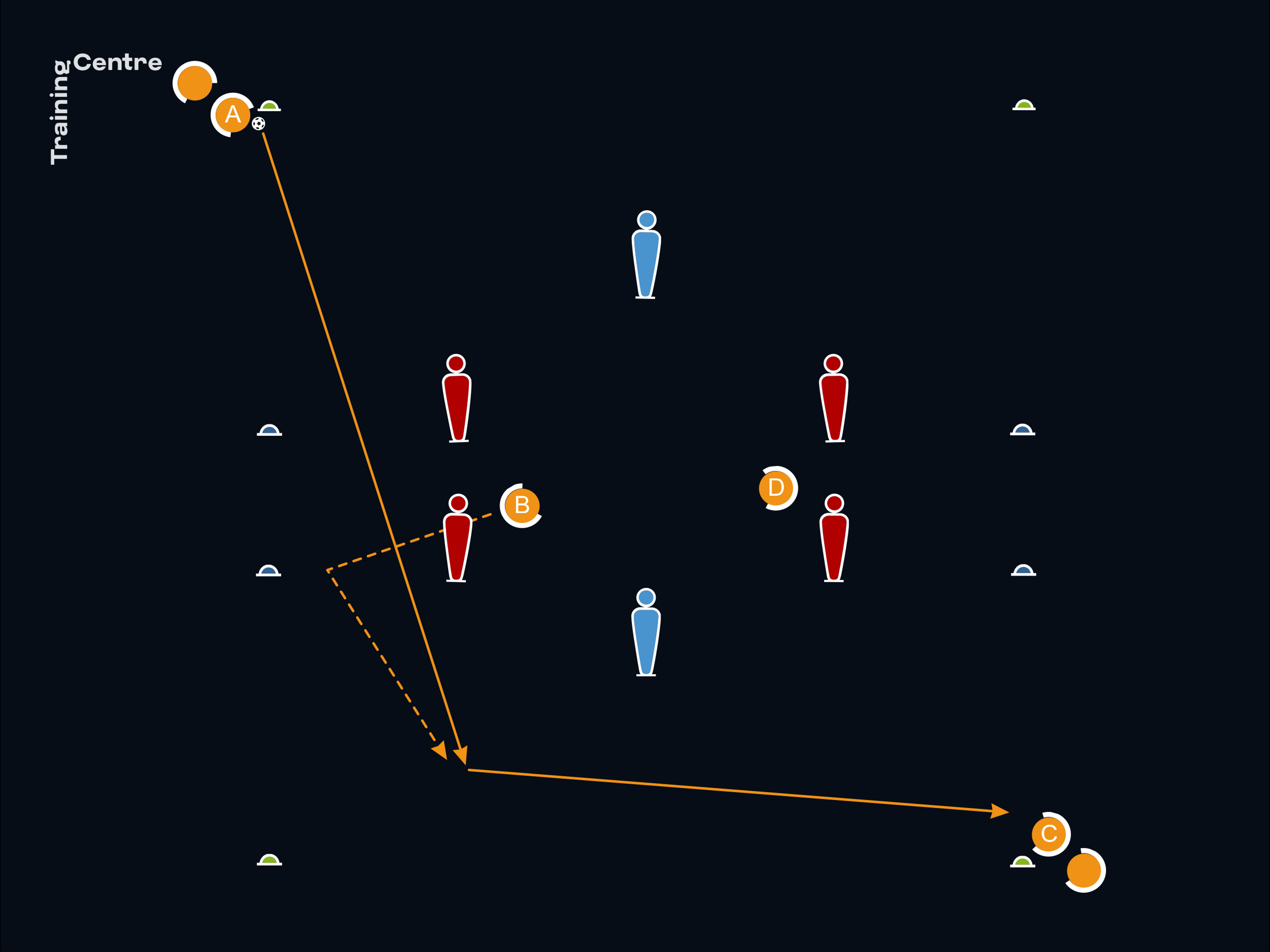
- A plays a pass to B into the space beyond the mannequin gate.
- From a starting position behind the mannequin gate, B shows quick feet to run backwards through the gate before facing A on the half-turn and pivoting into an angled position that allows the player to continue the sequence to C.
- B should move quickly to ensure that once the ball has passed the diagonal line from the wide mannequin, they are in a position to play a first-time diagonal pass out to C at the other end of the grid.
- C then starts the next sequence with D.
- A moves to B.
- B moves to C.
- D becomes the main player for the next sequence.
- Emphasise and encourage the one-touch and movement aspects of this drill.
- Players should play with their heads up and scan the area they are receiving the pass from and the intended destination of their own pass.
- Players must show quick feet as they play catch-up with the ball while letting it run across their body, before playing a quality first-time pass.
- Given that passes over longer distances require greater accuracy, the importance of B keeping their head up as the ball runs past their feet is even greater in this drill than in the others.
- NB: to promote complete technical balance, the directions and organisation should be inverted so as to encourage efficiency of movement and two-footedness.
- B should play a diagonal, right-footed pass to C, who is situated at the opposite corner of the grid.
- The opposite applies to the inverted drill sequence.
Drill 6: Three-player sequence in which third player is in motion
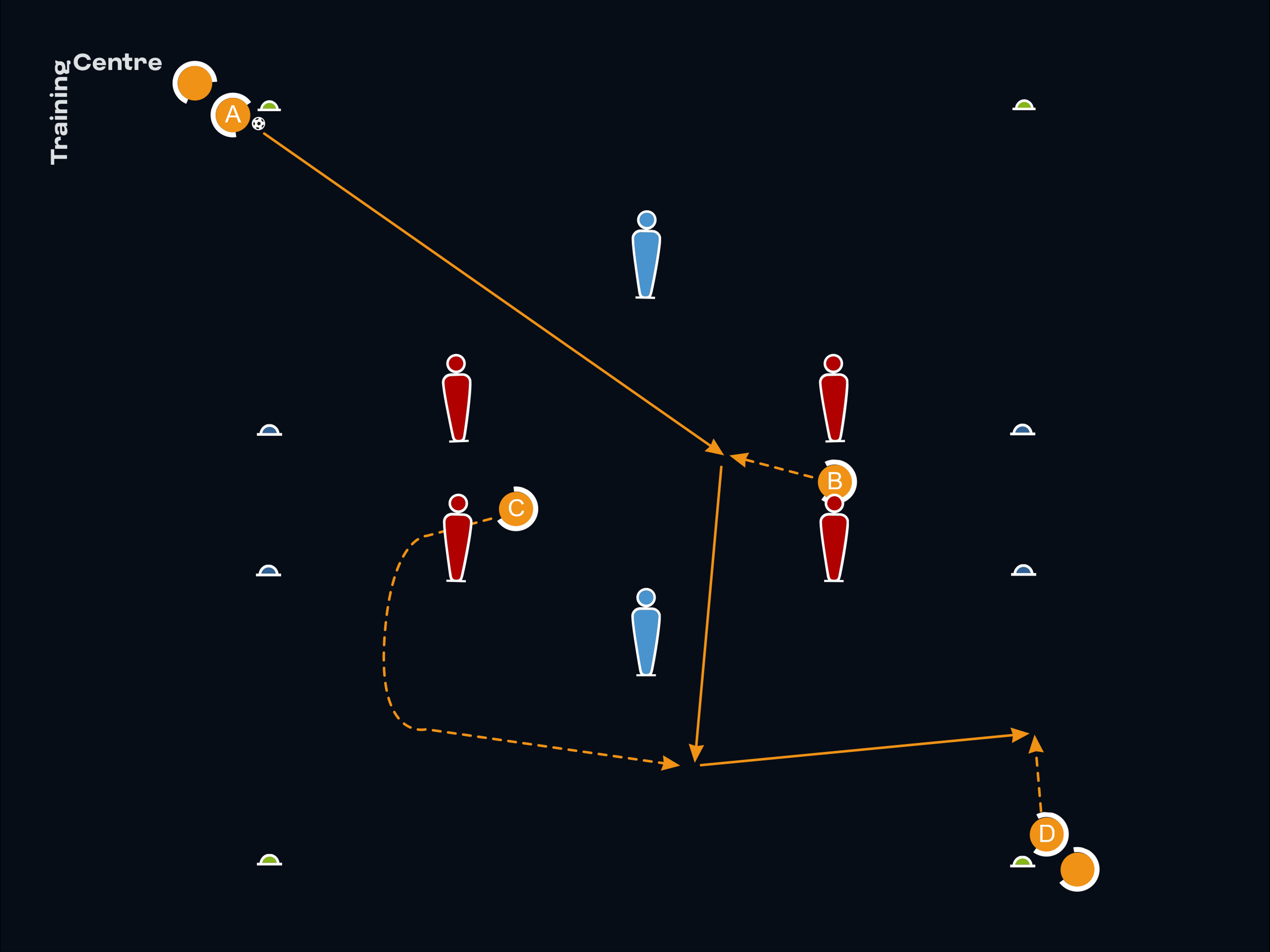
- A plays a 15m (diagonal) pass into the path of B, who is positioned in front of the second mannequin gate.
- B plays an angled first-time lay-off into the path of C.
- C spins out of the gate and makes a timed run around the wide mannequin to receive B's lay-off into the space behind the mannequin.
- C then plays a diagonal pass into the path of D, who is positioned in the top right-hand corner.
- D then starts the next sequence with A, who has moved into the position previously occupied by C.
- A moves to C.
- C moves to D.
- D starts the next sequence with A.
- Emphasise and encourage the one-touch and movement aspects of this drill.
- Players should play with their heads up and scan the area they are receiving the pass from and the intended destination of their own pass.
- Place the emphasis on playing a quality pass into the path of the next player in the sequence.
- Another significant focus point is ensuring that the timing of C's run coincides with the actions of A and B.
- NB: to promote complete technical balance, the directions and organisation should be inverted so as to encourage efficiency of movement and two-footedness.
- B may use either foot, depending on the quality of the pass from A and the receiving position.
- However, if A plays a good-quality pass, B should try to open up their body and meet the ball with a first-time, left-footed lay-off (the opposite applies when the sequence is inverted).
- The focus is on first-time lay-offs played with both feet and the coordination of movement between three players.
- C should try to play a right-footed pass to D (the opposite applies in the inverted sequence).
- The focus is on first-time lay-offs played with both feet and the coordination of movement between three players.
Drill 7: Quick passing, movement and support
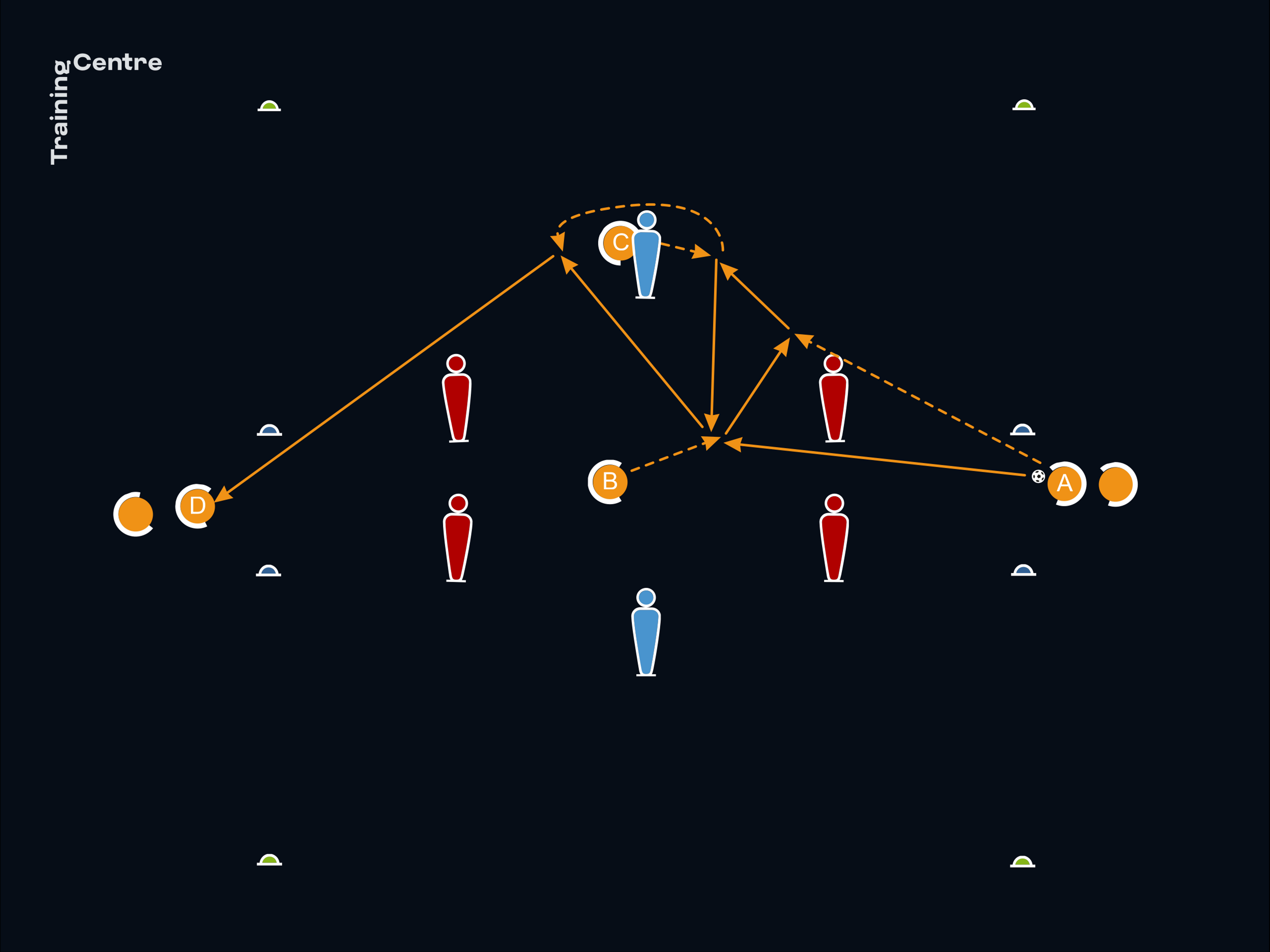
- A plays a straight pass to B through the nearest mannequin gate, before advancing diagonally to receive a lay-off from B.
- A then plays a short diagonal pass out to C, who is positioned outside the wide mannequin.
- C plays a short, first-time pass to B.
- B lays the ball off into C's path.
- C completes the sequence by playing a pass to D, who is positioned in the opposite starting position.
- D starts a new sequence.
- Every player follows their pass so as to ensure rotation and does so at pace.
- A moves to B.
- B moves to C.
- C moves to D.
- Encourage quick movement between positions, especially A and B.
- Emphasise and encourage the one-touch and movement aspects of this drill.
- Players should play with their heads up and scan the area they are receiving the pass from and the intended destination of their own pass.
- Place the emphasis on playing a quality pass into the path of the next player in the sequence.
- This drill is technically balanced, requiring an equal use of left and right foot.
- A should receive B's pass quickly with whichever foot is most suitable to play a first-time pass to C.
- B should play passes to A and C with whichever foot is most suitable with a view to playing the pass early and speeding the sequence up.
- C should play a one-two with B with whichever foot is most suitable with a view to playing the pass early and speeding the sequence up.
- When starting on the right side of the grid (as in the above illustration), the final pass of the sequence (to D) should be right-footed. When playing in the opposite direction, the last pass should be left-footed.
Drill 8: Timing and movement in a three-player drill
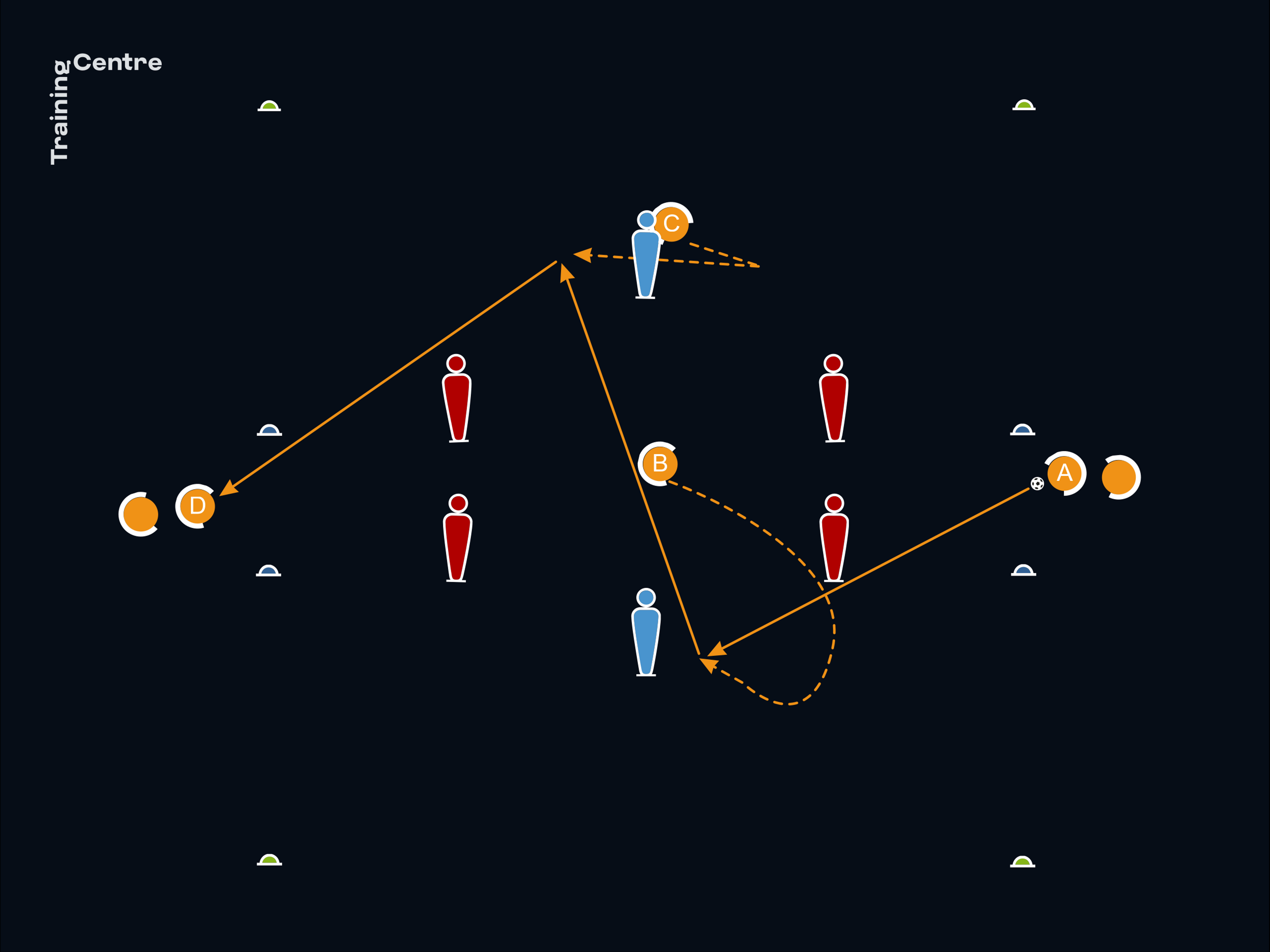
- A turns out and plays a short pass to the left, just outside the first mannequin gate.
- B starts between the two mannequin gates and receives the pass from A on the half-turn.
- B turns forward and plays a diagonal pass beyond the wide mannequin into C's path.
- C is positioned slightly behind the wide mannequin and makes a short (around 5m) burst to meet B's diagonal pass that is played into the space beyond the wide mannequin.
- C completes the sequence by playing a diagonal pass to D.
- D starts a new sequence.
- Every player follows their pass so as to ensure rotation.
- A races through the nearest mannequin gate.
- B quickly moves the ball out and into C’s path at the wide mannequin.
- C moves to D.
- Encourage quick movement between positions, especially A and B.
- Encourage B to scan towards C to receive the next pass and emphasise the importance of this.
- Encourage C to time their run to coincide with B's movement and pass and emphasise the importance of this.
- Encourage the coordinated movement of all three players and emphasise the importance of this.
- This drill is technically balanced, requiring an equal use of left and right foot.
- A should meet the ball and be ready to turn out and play a left-footed pass to B to the left. The opposite (right-footed pass) applies when D is in the starting position.
- B should use whichever foot is most suitable with a view to playing the pass to C early and speeding up the sequence.
- C should play a right-footed diagonal pass to D. The opposite (left-footed pass) applies when D is in the starting position.
Drill 9: Quality of first touch as basis for second
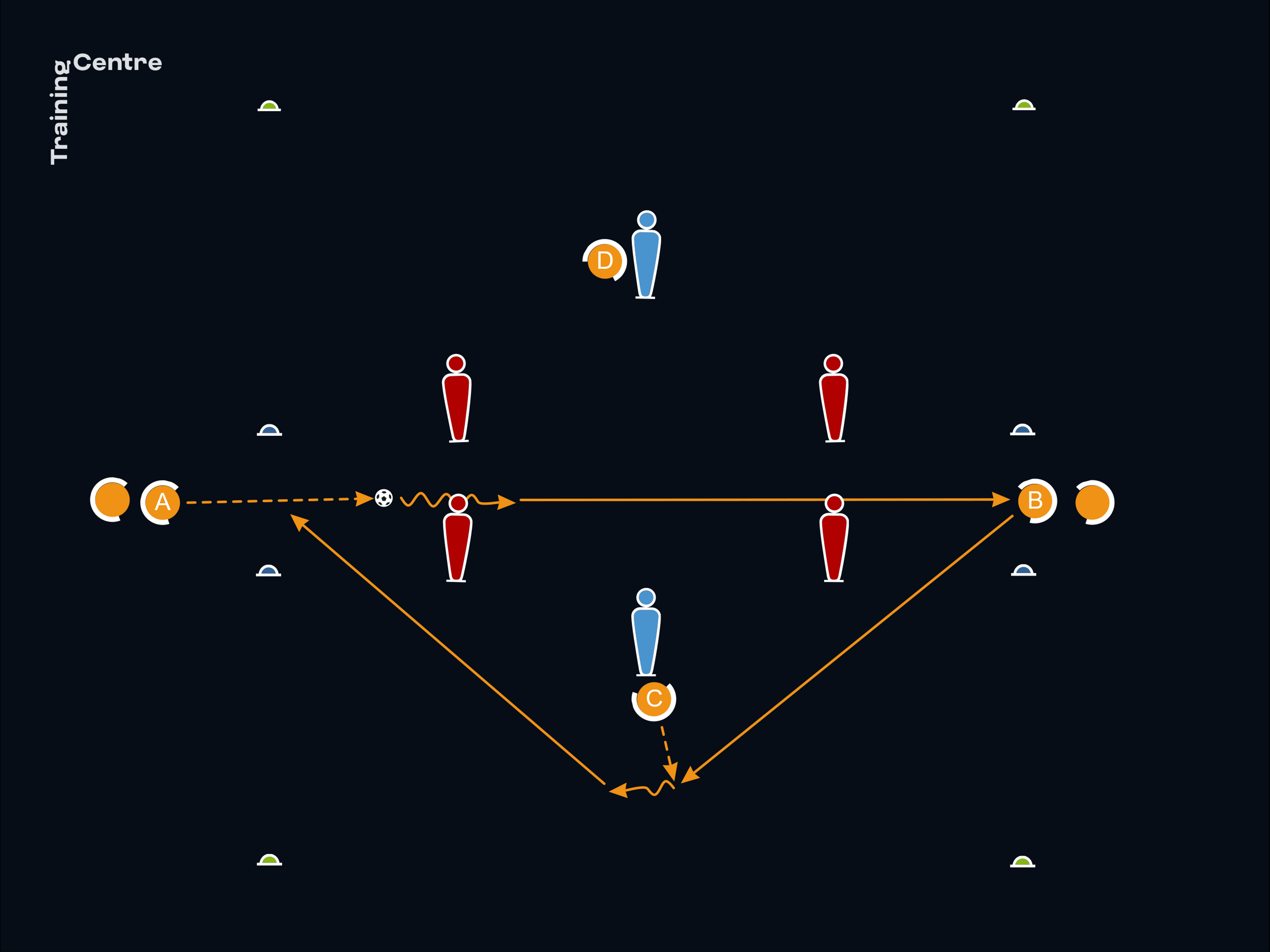
- A advances with the ball through the first mannequin gate, plays a long, straight pass to B that goes through the second mannequin gate and follows the pass.
- B then has the freedom to decide whether to continue the sequence to the right or left and plays the ball quickly to C or D with their second touch and follows the pass.
- C/D appears from slightly behind the wide mannequin and moves forward on the half-turn.
- If the quality of the pass from B is good enough, C/D looks to open up into a full forward position, move the ball beyond the wide mannequin and play a diagonal pass with their second touch to the next player in position A.
- The next player in position A starts the following sequence.
- Every player follows their pass so as to ensure rotation and does so at pace.
- A moves to B.
- B moves to C/D.
- C/D moves to A.
- With the second cycle, encourage A to step into C/D's pass with conviction and drive through the gate with their first touch.
- Encourage B to take a chance and play a first-time pass to C/D in the wide areas.
- Encourage players to play the pass to A across the latter's forward path, between A's starting position and the mannequin gate so as to raise the tempo and enhance the level of technical coordination.
- This drill is technically balanced, requiring an equal use of left and right foot.
- A should meet the pass from C/D with whichever foot is most suitable, but where possible, the foot used should be varied to promote technical balance.
- B should move the ball on the first touch with whichever foot is most suitable, but try to play a left-footed diagonal forward pass to the left. The opposite applies in the case of right-footed diagonal forward passes to the right.
- C should play a left-footed diagonal pass to A. The opposite applies for D, i.e. a right-footed pass should be played.










